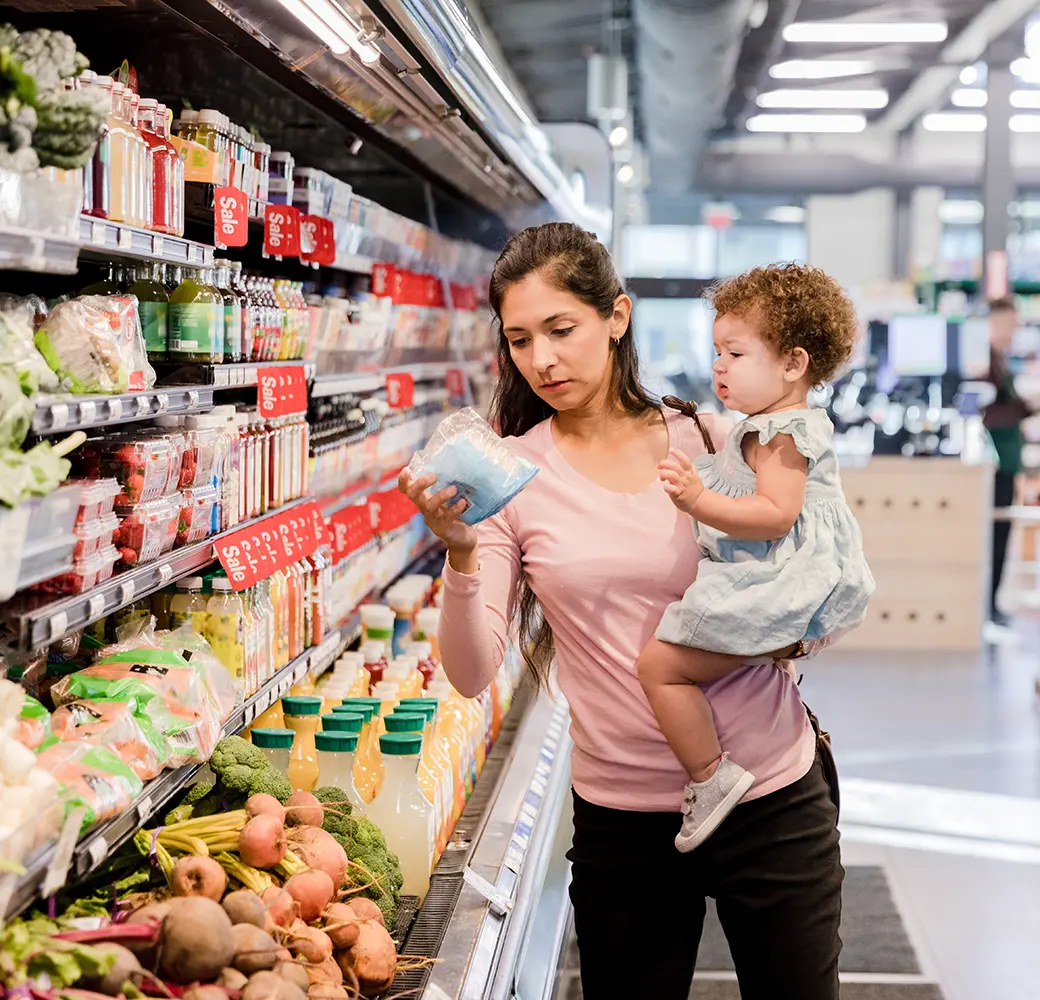It’s natural to waltz down grocery store aisles and add everything you see to your shopping cart. Strategically placed products catch your eye and make you think you need them immediately. Overspending at the grocery store is a habit that’s difficult to break—but it can be done. Here are 15 ways you can save during your next trip to the supermarket:
1. Check your pantry to plan meals and avoid food waste
Before you head to the store, check to see what grocery items you already have to avoid overspending on unnecessary purchases. One thing that’s helped me is keeping a list on my phone of everything in my pantry, fridge, and freezer. Then, I plan meals with the things I have and make a grocery list for anything that’s necessary. You can also check sites like Supercook or Cookpad, that help you find recipes based on ingredients, or apps like Paprika or Mealime, to plan your grocery lists and meals. Knowing what’s in your pantry or fridge can help you make meals with what you have and avoid going to the grocery store altogether.
2. Make the most of storage
Knowing what you have is only half the battle. It’s also important that you’re storing your food properly to make the most of your purchases. In the United States, food waste costs the economy over $408 billion annually, with the average American family of four losing around $1,500 a year to uneaten food.
Be mindful of expiration dates. Techniques like freezing and vacuum sealing can help keep your food safe for longer, which may be useful when you find your favorites on sale at the store. It’s also important to store your dry goods in airtight containers. Not sure of the best way to store your groceries? Check out Save the Food for information about refrigeration, freezing, and more.
3. Make a grocery list to save money and stay on budget
Compile a list to be sure you’re purchasing the essentials, and stick with it. Don’t stray from your list—you’ll spend more money than you intended. Another way to save money—and time—is by ordering your groceries for pickup. Some stores offer free curbside pickup, which can help you save time at the store but also help you avoid impulse purchases. Grocery apps are also a great place to check for coupons, and you can usually save them for easy use at checkout.
4. Compare grocery prices across multiple stores for best deals
While you’re determining your list, create a grocery store comparison chart. Pick your essential items, choose your stores, obtain the prices, and compare. It’s an invaluable tool that will ultimately save you money.
5. Use coupons and loyalty programs to maximize savings
This seems obvious, but using coupons can help tremendously. There are dozens of websites, like coupons.com, that offer free, printable coupons and online coupons to maximize savings on grocery expenses. Also, be sure to read your local store’s circular—it promotes items that are on sale. In addition to circulars, look for digital coupons that are store-specific. Another great way to save money is with Ibotta. Once you have your shopping list, check the app for relevant offers. Then hit the grocery store, submit your receipt, and earn cash back. Cha-ching!
6. Don’t shop hungry to avoid impulse buying
The golden rule of grocery shopping: don’t shop hungry. According to Psychology Today, when you’re hungry, you overload your shopping cart with items you don’t need. Your brain focuses on finding its next food source, so you grab everything appealing within sight. To combat this, be sure you’ve eaten before you go. You’ll avoid the temptation of grabbing unnecessary items, and your wallet will thank you.
7. Leave the big spenders at home to stick to your budget
Whether it’s your kids or your spouse, there’s always someone adding more than you need to your cart. It’s not always easy to say no, so avoid the situation entirely by leaving your big spenders at home, if you can.
8. Keep a running tally of your cart’s cost
Steer clear of the dreaded, “I spent how much?!” when you make it through the check-out line. As you add items to your cart, keep track of the running cost. It doesn’t need to be exact—just a rough estimate.
9. Avoid eye-level items to find lower-priced items
It may be easier to grab the first option you see, but scanning the shelves is critical. Stores use the motto “eye level is buy level” for a reason. We look at items that are eye level, so that’s where grocery stores place the most expensive items. Look for cheaper items on higher and lower shelves.
10. Skip pre-cut food to save money
It’s often simpler to purchase ready-to-eat salad and fruit, but that’ll cost you more in the long run. You won’t receive as much, either, and pre-cut food doesn’t stay fresh for long. Trust me—just buy the head of lettuce and make your salad. It’ll take less than ten minutes, and you’ll save money.
11. Ask for a rain check on out-of-stock grocery items
Did someone get too greedy during the BOGO sale? You can ask your store for a rain check on items that sold out during a promotion. If your grocer allows it, you can snag the item once the store restocks.
12. Don’t always buy in bulk
It seems cheaper but buying in bulk isn’t always the best choice. Sometimes, depending on the unit price, it can wind up being more expensive. If you’re debating whether you should purchase items in bulk, it’s crucial to check the unit prices on canned goods, dairy products, and other staples to see if you’re saving or spending more.
13. Try generic brands
Don’t be afraid to try the store brand. It’s often just as good as the national brand but a fraction of the cost. If you don’t like it, most grocery stores will allow you to return it and get your money back or swap for the national brand.
14. Shop in season
If you’re purchasing fresh produce, be sure to buy items that are in season to enjoy lower prices and eat healthy. Not only is it fresher and tastier, but it also costs less. It’s all about supply and demand. When produce is in season, there’s an abundance—therefore, it costs less per pound. Compared with something out of season—there’s less of the product in-store, so it’s more expensive. Check out the Seasonal Food Guide to see when the best time is to buy produce by state and by month. Another easy way to shop seasonally is to visit your local farmers’ markets or CSAs. And of course, don’t forget those storage tips! Plenty of produce can be bought seasonally and be frozen or canned for later use.
15. Pay with cash
When budgeting, cash is king. Paying for items with cash allows you to set a budget and stick with it—once your cash for an item runs out, that’s it. Finance expert Dave Ramsey swears by this method. Bring enough money to cover your groceries for one trip. If your total runs over, take items in your cart out. It’s hard, but better than ruining your monthly budget.
Key takeaways:
- Keep track of what you have in your fridge and pantry to cut down on wasted food.
- Plan your meals with what you have and then shop for what you need.
- Check coupons, grocery store apps, and cash back apps to make the most of your budget.
Changing how you grocery shop can have a notable impact on your financial well-being. By shopping sensibly, you can stick to your monthly budget, as well as reach other money-related goals you may have. Try one, or some, of these tips next time you’re at the grocery store—you’ll be amazed at how much you save.





